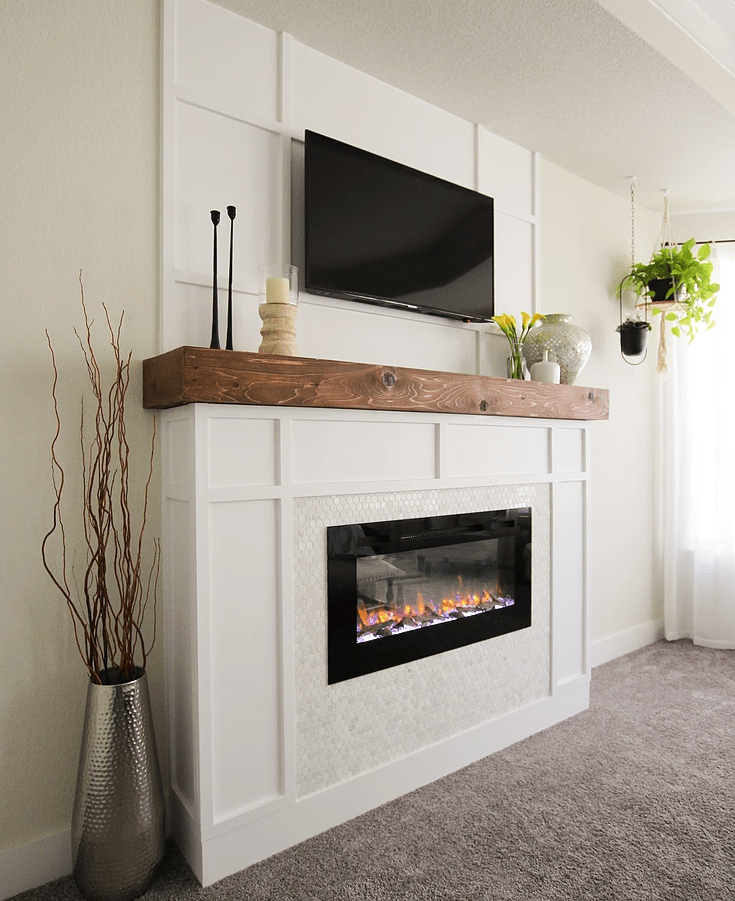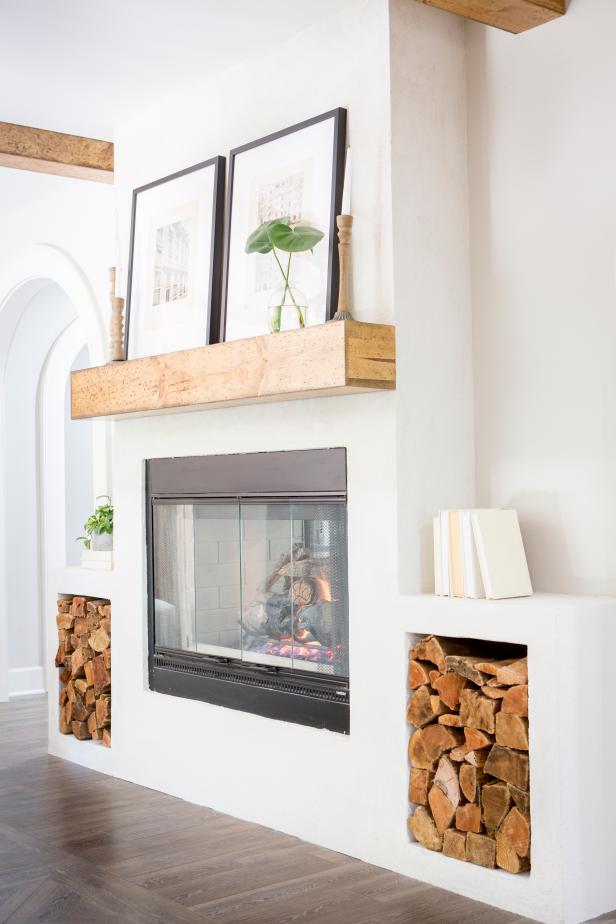I’ve always believed that a fireplace is the center of any living space, and the appropriate surround can drastically transform its appearance. After years of interior design experience and numerous home renovations, I’ve realized that gas fireplace surrounds are quite versatile for creating magnificent focal pieces. Whether you’re dealing with a modern open-plan layout or a conventional family room, the surround you choose will determine the overall feel of your area.
Modern Minimalistic Approaches
My favorite contemporary technique uses clean lines and neutral materials to produce a sophisticated visual impression. I frequently recommend big format porcelain tiles in concrete or marble textures because they create smooth surfaces that complement modern furniture flawlessly. The idea is to select materials with modest texture differences that offer depth without dominating the room.
When designing minimalist surrounds, I strive to create negative space that allows the fire to be the focal point. This design works especially effectively in open-concept houses because the fireplace must blend smoothly with the kitchen and dining rooms. Simple geometric designs and monochrome color schemes contribute to this seamless elegance.
The charm of minimalist design stems from its ageless appeal and low maintenance requirements. I’ve discovered that clients love how these settings age beautifully and remain stylistically current for decades. Avoiding trendy components and focusing on high-quality materials results in an investment that increases the long-term worth of your property.
Traditional Stone and Brick Options
Natural stone surrounds remain my favorite choice for homes looking for timeless elegance with long-term appeal. I enjoy working with fieldstone, limestone, and travertine because they add organic texture and warmth to any environment. These materials work well with both rustic and elegant interior styles, making them extremely versatile options.
Brick surrounds have a timeless beauty that I find particularly appealing in family rooms and intimate gathering areas. I frequently recommend painted brick to clients who desire traditional appeal with a fresh, updated appearance. White or white brick produces a light, open atmosphere, whereas darker tones give dramatic elegance to bigger rooms.
Stone and brick are long-lasting investments that require little maintenance over time. I’ve seen these materials last decades of use while improving in look through natural patina. This aging process imparts character that synthetic materials simply cannot match.

Wood and Mixed Material Combinations
Combining wood pieces with stone or metal results in rich, layered designs that I find particularly appealing in a variety of settings. Reclaimed barn wood combined with natural stone creates a rustic elegance that works well in both classic and contemporary settings. The contrast between smooth stone and rough wood adds visual intrigue without being cluttered.
I enjoy combining live-edge wood mantels with sleek metal or stone surrounds for clients looking for one-of-a-kind focal pieces. This mix strikes a balance between organic warmth and modern sophistication, resulting in surroundings that feel both current and timeless. The intrinsic differences in wood grain make each installation unique.
Mixed materials enable for creative expression while also providing the practical functionality that busy families require daily. I’ve discovered that these combinations photograph wonderfully and make wonderful backdrops for holiday decorations and family gatherings. Their adaptability makes them ideal for those who prefer altering their design seasonally.
Contemporary Metal and Glass Features
Stainless steel and blackened metal surrounds make bold modern statements, which I especially recommend for urban lofts and contemporary homes. These materials reflect light nicely and look great with other metal fixtures in your room. The industrial look appeals to homeowners who value clear architectural lines.
Glass tile surrounds provide excellent light reflection and color options, which can significantly lighten darkish rooms. I frequently use subway-style glass tiles in neutral tones for a subtle elegance, or vibrant hues for dramatic accent walls. Glass is ideal for busy houses with children and dogs because it is easy to clean and stain resistant.
Metal and glass options work particularly well in open-plan designs where the fireplace must compliment modern kitchen appliances and fixtures. I’ve discovered that these materials produce a consistent design flow across connected living spaces. Reflective qualities serve to diffuse natural light and make tiny spaces appear larger.
Budget-Friendly DIY Solutions
Painted drywall surrounds provide amazing versatility for homeowners with tight renovation budgets but limitless creative freedom. I’ve helped clients create gorgeous focal areas using basic frame techniques and high-quality paint finishes. Bold accent colors or refined neutral tones can dramatically change ordinary surroundings into designer-worthy elements.
Tile overlay projects are a cost-effective option to enhance existing surrounds without requiring extensive demolition or construction work. I recommend ceramic subway tiles, hexagonal patterns, or geometric shapes to offer visual appeal while staying within restoration budget. These projects usually take one weekend and yield professional-looking results using simple DIY abilities.
Faux finishing techniques enable imaginative homeowners to create expensive-looking stone or wood appearances with simple materials and artistic talents. I’ve seen incredible transformations with textured paint, stencils, and glazing techniques that cost under $200. These tactics are especially effective for renters looking for temporary but significant improvements.
Professional Installation Considerations
Professional installation is required for gas fireplace surrounds due to safety concerns, particularly when electrical or gas connections need to be modified during restoration projects. I usually recommend choosing qualified personnel that understand local construction codes and product specifications. This investment protects your family and provides enough insurance coverage.
Structural considerations are critical when adding massive stone or masonry surrounds that necessitate additional floor and wall support systems. Before beginning installation work, professional contractors can analyze the structural and foundation needs of your home. This planning eliminates costly repairs and maintains the long-term durability of your investment.
Professional installation usually includes warranties and continuous service support, which protects your investment for years after completion. I’ve discovered that clients like having dependable connections for maintenance and repair needs that unavoidably occur over time. Most homeowners believe that the extra cost is justified by the peace of mind it provides.
What is the most economical material for a gas fireplace surround?
Painted drywall is the most cost-effective alternative for building appealing fireplace surrounds that can be customized with any color or finish you like. I’ve helped numerous clients achieve spectacular effects by combining high-quality paint, innovative molding, and basic construction abilities. This strategy typically costs less than $300 and can be performed in one weekend using simple equipment and materials.
How can I select the appropriate size surround for my room?
Room proportions should drive your surround size selection, with larger rooms allowing for more substantial surrounds and smaller areas needing more modest designs. I recommend measuring the size of your walls and existing furniture to guarantee suitable scale connections. The surround should enhance rather than overpower your room’s other architectural features and furniture components.
Can I install a fireplace surround myself, or do I require expert help?
Simple cosmetic repairs, such as painting or tile overlay, can be completed by yourself, but structural adjustments or gas line modifications must always be installed by an expert for safety reasons. I strongly advise employing certified technicians for any work requiring electrical, gas, or substantial structural changes. Basic decorative alterations are usually safe for seasoned DIY enthusiasts with the right tools.
How much upkeep do different surround materials require?
Natural stone requires annual sealing to avoid stains and moisture damage, whereas ceramic tiles merely require regular washing with mild detergents and water. Metal surrounds benefit from regular polishing to keep their shine, and wood pieces require occasional refinishing to keep their appearance. I propose creating maintenance plans based on your individual material choices.
How do I ensure that my surround complements my current decor?
When choosing surround materials and colors, keep your room’s current color palette, architectural style, and furniture finishes in mind for a consistent design flow. Before making any final decisions, I recommend establishing mood boards with fabric samples, paint chips, and material examples. This visual planning ensures that your new surround complement rather than clashes with your existing interior decor.
What are the current trends in gas fireplace surround design?
Current trends embrace diverse materials, bold geometric patterns, and dramatic color contrasts to create eye-catching focal pieces in modern living spaces. I’m witnessing a rise in demand for textured surfaces, asymmetrical designs, and integration with built-in storage options. However, I always recommend selecting styles that match your personal preferences rather than following fleeting fads that may suddenly become obsolete.
Fireplace Surrounds ideas fireplace surrounds, fireplace
Best Fireplace Mantel Designs – Interior Surround Ideas
Related Posts:








